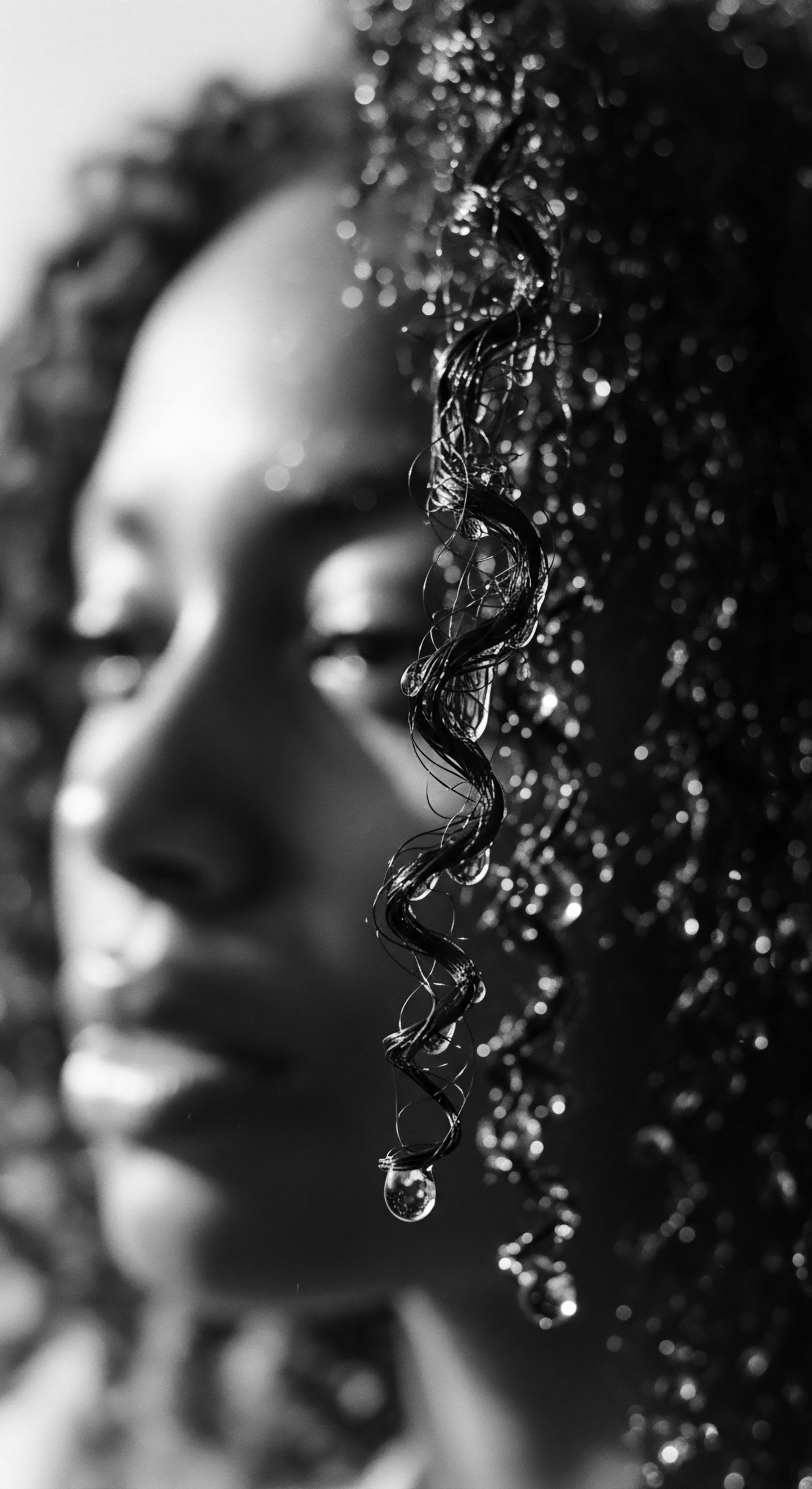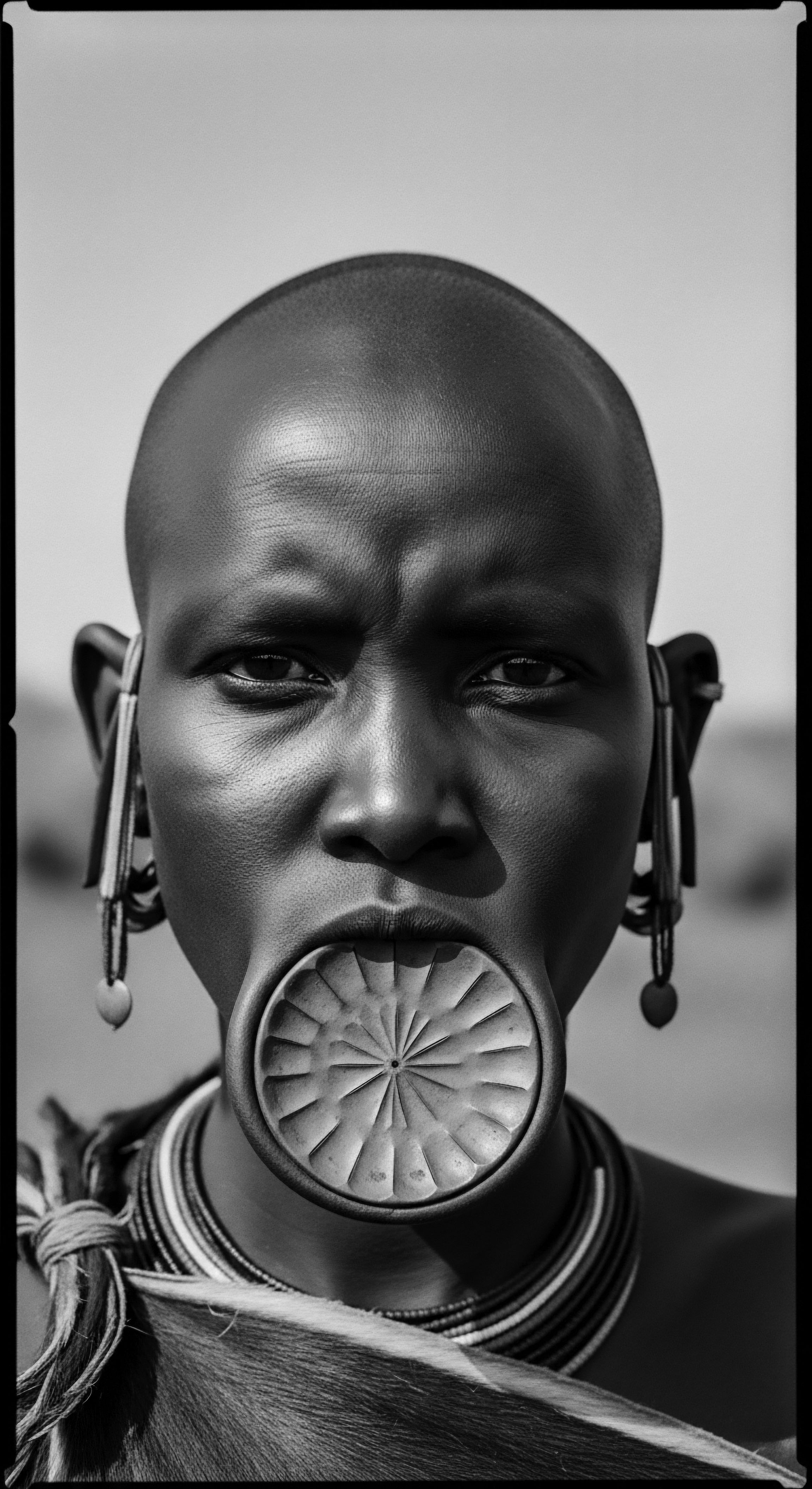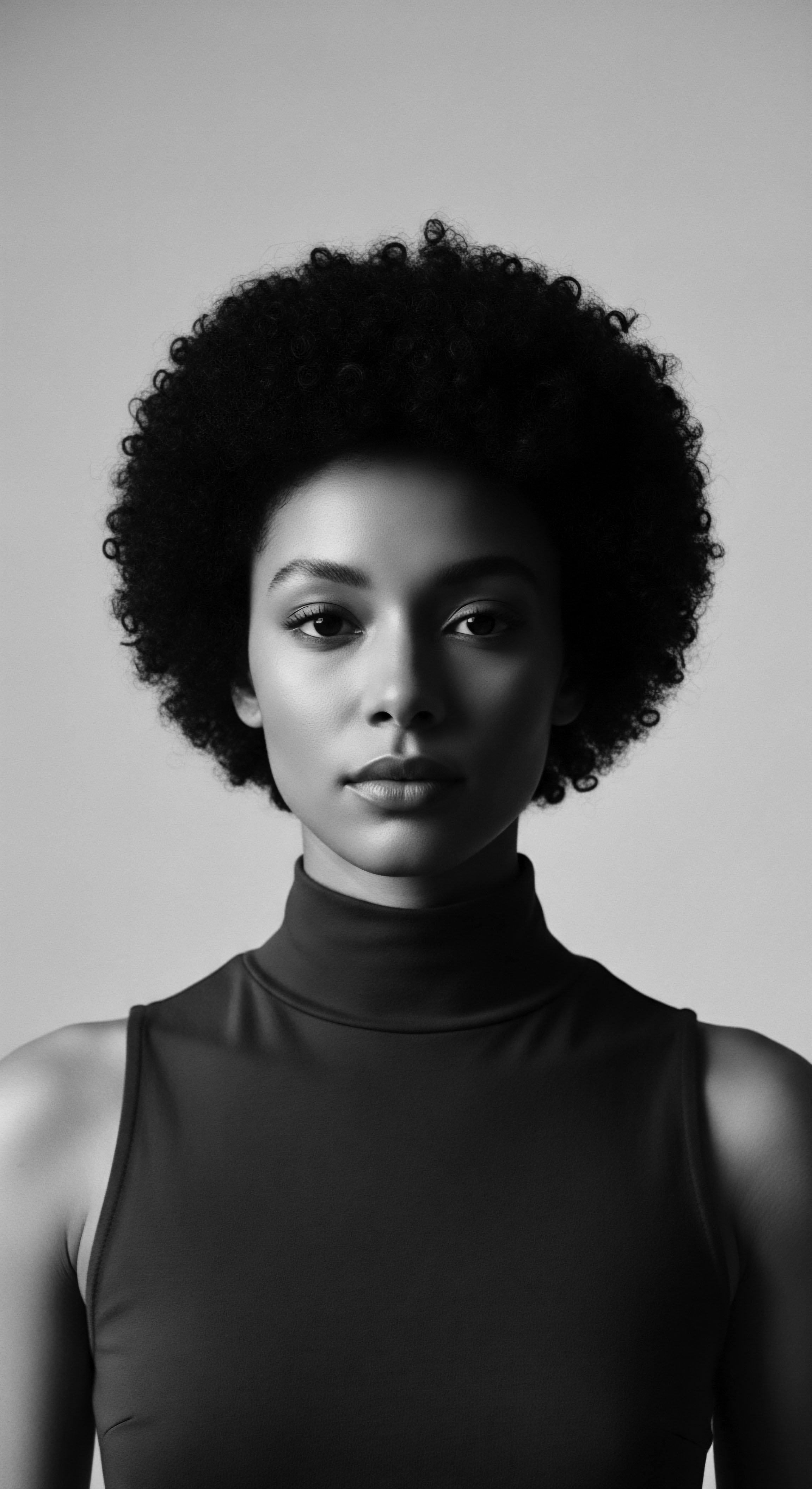
Fundamentals
Water, in its most elemental form, stands as the primal elixir, a silent witness to the dawn of life itself. For textured hair, especially, its presence is not merely a matter of cleansing or rinsing; it embodies a profound ritual, a foundational principle of vitality passed down through generations. To speak of Water for Hair is to begin a conversation with the very source of resilience, a dialogue that echoes across vast landscapes and intimate hearths where hair care traditions took root. Its fundamental meaning extends beyond simple chemistry, touching upon the intuitive wisdom that recognized its capacity to awaken dormant strands, to soften, and to prepare the hair for nurturing practices.
The elementary understanding of water’s role in hair care has always been deeply ingrained within ancestral communities. Long before the advent of modern cosmetic science, those who tended to coils and curls discerned the unique relationship textured hair maintains with moisture. Water allows the hair cuticle to swell gently, thereby rendering the strands more pliable, more receptive to the emollients and humectants provided by nature’s bounty.
This initial interaction, seemingly straightforward, establishes the very foundation for effective care. Without this softening embrace, the intricate patterns of textured hair can resist manipulation, inviting friction and potential damage.
Water for Hair represents the primal wisdom of ancestral communities, recognizing its power to soften and prepare textured strands for nurturing.
Consider the most basic human actions ❉ washing, refreshing, preparing. These acts, when applied to hair, were never performed in isolation. They formed part of a larger continuum of self-care and communal bonding. The early applications of water were straightforward, perhaps a dip in a flowing stream, or the gathering of fresh rainwater, yet their impact was transformative.
They enabled the gentle release of accumulated dust and environmental elements, clearing the way for ancestral balms and botanical infusions to truly take hold. This foundational interaction between water and hair laid the groundwork for complex care regimens that would evolve over centuries, each generation refining techniques, but always honoring water as the initial touchpoint.

The Sacred Cleansing Current
Across diverse cultural landscapes, water often held a sacred significance, a living current connecting the terrestrial with the spiritual. For hair, this sacred perception translated into a mindful approach to cleansing. The act of washing became a ritual of purification, not just of the physical strand, but also of the spirit. This deep-seated belief system underscores why early hair care practices were so intentional.
The earliest cleansers were often derived from natural sources that interacted harmoniously with water. Think of the saponins present in certain plants, which, when combined with water, created a gentle lather to purify the hair without stripping its inherent strength. This careful interplay between water and plant-based ingredients ensured that the hair’s delicate structure remained undisturbed, respecting its natural integrity.
The rhythmic application of water during cleansing often transformed into a communal activity, especially among women. This shared practice reinforced social ties and facilitated the transmission of hair knowledge from elder to youth. In many West African communities, the preparation of traditional cleansers involved collective effort, from gathering the specific plant parts to mixing them with water to form the desired consistency.
The communal aspect imbued the process with shared meaning, transforming a practical necessity into a moment of connection and cultural reaffirmation. The water used in these collective rites was understood as more than a solvent; it was a conduit for generational wisdom.

Elemental Properties and Initial Interaction
From a fundamental perspective, water’s unique molecular structure, with its polarity, enables it to interact powerfully with hair. This interaction influences the hair’s pliability, its ability to swell, and its response to subsequent products. When textured hair absorbs water, it experiences a temporary expansion, a phenomenon vital for elasticity and preventing breakage during manipulation. This initial ‘wetting’ process is critical.
A hair strand that resists water, whether due to product build-up or hydrophobic coatings, will be less cooperative and prone to damage. Understanding this basic principle is the initial step in truly honoring textured hair.
- Hydration Potential ❉ Water serves as the primary source of hydration, allowing hair fibers to absorb moisture, which is essential for maintaining elasticity and preventing brittleness.
- Detangling Aid ❉ The application of water softens strands, making them more amenable to detangling and reducing the mechanical stress that can lead to breakage.
- Product Activation ❉ Water acts as a solvent and a medium for activating and distributing natural cleansers, conditioners, and styling agents across the hair.
Water, therefore, is not a mere backdrop to textured hair care; it is the stage upon which all other acts of nurturing unfold. Its gentle, permeating touch prepares each coil and curl, allowing for the deeper absorption of beneficial compounds and preserving the hair’s innate beauty. This foundational understanding, rooted in the collective wisdom of those who came before us, remains as relevant today as it was in ancient times, a continuous whisper from the source.

Intermediate
Moving beyond its fundamental understanding, the intermediate meaning of Water for Hair delves into its practical applications, nuanced implications, and the conscious recognition of its varied forms within the journey of textured hair care. It shifts from an elemental acknowledgement to a thoughtful engagement with water as a dynamic partner in hair health, a partner whose qualities and interactions warrant careful consideration. Here, the ancestral wisdom begins to articulate itself through specific preparations and purposeful practices, recognizing that not all water is identical, nor are all interactions universal. This level of understanding speaks to the discerning touch of generations who refined their methods through observation and lived experience.
The significance of Water for Hair at this stage involves acknowledging its role as a carrier and an activator. It becomes the vehicle for botanical infusions, the medium for traditional pastes, and the catalyst that awakens dormant ingredients. This understanding represents a deeper appreciation for how water facilitates the delivery of nutrients, conditioning agents, and medicinal properties from natural sources directly to the hair and scalp.
It is here that we truly begin to see the intentionality behind ancestral practices, where water was not simply present but was an active participant in the therapeutic and beautifying process. The meticulous crafting of water-based solutions, steeped in time and tradition, speaks to an intimate knowledge of nature’s offerings.

The Ancestral Alchemy of Water and Botanicals
Across the vast landscape of African hair care traditions, the art of combining water with specific botanicals reached a remarkable level of sophistication. Women, custodians of this inherited knowledge, learned to harness the solvent properties of water to extract beneficial compounds from plants. These preparations were more than simple rinses; they were potent concoctions designed to address particular hair and scalp needs.
For instance, the use of various barks, leaves, and roots to create infusions for strengthening strands or soothing irritated scalps speaks to a deep ethnobotanical understanding. The water, infused with these plant essences, became a living elixir, carrying the healing power of the earth directly to the hair.
One profound example of water’s central place in ancestral hair care is found in the tradition of African Black Soap , or ‘ose dudu’ among the Yoruba of Nigeria, ‘alata simena’ in Ghana, and ‘sabulun salo’ in Mali. This revered cleanser is not merely a soap; it is a cultural icon, a testament to the ingenuity of West African communities. Its creation inherently ties to water, which acts as a crucial component in processing the plant-based ash (from plantain skins, cocoa pods, palm tree leaves, and shea tree bark) and blending it with natural oils. This water-soluble cleansing agent, gentle yet effective, has been used for centuries to purify the scalp and hair, demonstrating an early understanding of pH balance and mild surfactants long before these terms entered scientific discourse.
The act of preparing African Black Soap was, and often remains, a communal undertaking, embodying shared heritage and collective purpose. Ogunbiyi and Enechukwu (2021) highlight its cleansing and medicinal properties, noting its popularity amongst those of African descent for its natural and holistic approach. The water, in this context, does not merely cleanse; it connects hands that stir, voices that sing, and wisdom that flows through generations, forming a continuous stream of care.
| Traditional Ingredient/Practice African Black Soap (Ose Dudu) |
| Water's Function Solvent for plant ash; medium for blending with oils. |
| Benefits for Textured Hair Gentle, deep cleansing; scalp purification; preserves natural oils. |
| Traditional Ingredient/Practice Baobab Fruit/Oil Infusions |
| Water's Function Extraction of nutrients; creation of hair-conditioning pastes. |
| Benefits for Textured Hair Moisture retention; conditioning; frizz reduction; scalp health. |
| Traditional Ingredient/Practice Herbal Rinses (e.g. Hibiscus) |
| Water's Function Infusion medium for plant compounds; final acidic rinse. |
| Benefits for Textured Hair Shine enhancement; pH balancing; scalp invigoration. |
| Traditional Ingredient/Practice These practices underscore how water was strategically employed to enhance the efficacy of natural ingredients within ancestral hair care rituals. |
The Baobab tree, often referred to as the “Tree of Life” throughout Africa, further illustrates this deep association. Its fruits yield oil, and ancient folklore suggests that water infused with baobab seeds could bring strength and health to hair. This is not merely superstition; the oil, extracted from the seeds, when used with water in conditioning treatments, provides a remarkable ability to nourish, protect, and reduce frizz, particularly for curly and coily strands. Its rich fatty acid profile, as explored by Mokganya et al.
(2018), works in harmony with water to seal in moisture and fortify the hair cuticle, a process deeply valued in traditional practices. The interaction of water with such potent botanical extracts speaks to an intuitive, nuanced understanding of hair’s needs, passed down through generations.

Water Quality and Observational Wisdom
At an intermediate level of comprehension, awareness of water quality gains significance. Ancestors may not have had laboratories to measure pH or mineral content, yet their keen observation guided their choices. They likely noted how rainwater, soft and pure, left hair feeling different from river water, which might vary with its mineral composition from locale to locale. This observational wisdom informed which water sources were preferred for specific hair rituals.
Hard water, heavy with minerals, can leave a residue on hair, making it feel rough or dry. Soft water, conversely, allows cleansers to lather more freely and rinse cleanly, leaving hair softer and more manageable. The preference for collecting rainwater or drawing from certain wells for hair care was a testament to this empirical understanding.
Observational wisdom, though lacking modern scientific terms, guided ancestral preferences for water quality in hair care.
This nuanced awareness is not limited to mineral content. The temperature of water also played a subtle but meaningful role. Lukewarm water was understood to gently open the hair cuticle, facilitating cleansing and conditioning, while a cool rinse could help seal the cuticle, promoting shine and reducing frizz.
These distinctions, honed over centuries of practice, represent an intermediate engagement with Water for Hair, where the substance is not merely present but is intentionally manipulated to achieve optimal results. This thoughtful approach reveals a deep respect for the hair itself and a continuous pursuit of practices that honored its inherent texture and strength.
The knowledge accumulated through generations of women, shared in communal settings, allowed for the development of adaptive strategies. When certain water sources were scarce or problematic, ingenious methods of preparation, purification, or complementary ingredient use would emerge. This adaptability underscores the dynamic nature of ancestral hair care, where the deep meaning of Water for Hair was continuously reinterpreted and reaffirmed through lived experience and collective wisdom. It was a fluid, evolving body of knowledge, much like water itself.

Academic
The academic elucidation of Water for Hair transcends simplistic definitions, unfolding as a complex interplay of biophysics, cultural anthropology, and historical sociology, all contextualized within the unique architecture of textured hair. This scholarly lens reveals that water, in this context, is not merely a chemical compound (H2O); it is a dynamic participant in the hair’s structural integrity, a historical constant in cultural practices, and a silent narrator of diasporic experiences. The full complexity of Water for Hair encompasses its molecular interactions with the keratinous fiber, its ecological availability shaping ancestral traditions, and its symbolic resonance within collective identity. It requires an interdisciplinary approach, drawing from material science, ethnobotany, and cultural studies, to truly grasp its profound meaning and enduring significance.

The Biophysical Nexus of Water and Keratin
At the molecular level, water’s interaction with textured hair is a phenomenon of intricate hydrogen bonding and osmotic dynamics. The unique helical structures of keratinocytes, which form the hair fiber, possess a high affinity for water molecules. This affinity is particularly pronounced in textured hair due to its elliptical cross-section and the uneven distribution of disulfide bonds along the fiber, creating areas of varying porosity. When water molecules permeate the hair shaft, they engage in hydrogen bonding with the hydrophilic regions of keratin proteins.
This leads to a phenomenon known as ‘hygral expansion’ or swelling of the hair fiber. While this swelling renders the hair more pliable and amenable to manipulation – critical for detangling and styling without incurring mechanical damage – it also represents a cycle of expansion and contraction that can, over time, contribute to fatigue of the cuticle, often termed ‘hygral fatigue.’
The academic perspective compels an examination of the ‘moisture memory’ of textured hair. This refers to the hair’s inherent capacity to absorb and retain water, a property deeply intertwined with its structural characteristics. Maintaining optimal hydration is paramount for textured hair, as it directly influences its elasticity, strength, and overall resilience. An inadequate supply of water can lead to a decrease in the hair’s elastic modulus, rendering it brittle and prone to breakage during routine manipulation.
Conversely, prolonged exposure to water without proper sealing can lead to excessive swelling, potentially lifting the cuticle scales and exposing the hair’s internal cortex, thereby diminishing its protective barrier. The optimal management of water involves a delicate equilibrium, where hydration is maximized, and potential hygral fatigue is mitigated through strategic product application and care regimens.
- Hydrophilic Interaction ❉ Water molecules directly bind with keratin, influencing the hair’s elasticity and pliability.
- Cuticle Response ❉ Water absorption causes the hair cuticle to swell, which facilitates the infusion of conditioning agents but also necessitates thoughtful sealing to prevent damage.
- Hygral Fatigue Considerations ❉ The continuous cycle of wetting and drying can stress the hair fiber, highlighting the importance of balanced moisture and protein treatments.

Ethnobotanical Traditions and Hydration Strategies
From an ethnobotanical viewpoint, the meaning of Water for Hair is inextricably linked to the utilization of indigenous plants as hydrating and conditioning agents. Ancestral communities, through generations of empirical observation, developed sophisticated taxonomies of local flora based on their observed effects on hair. The preparation methods often centered on water as the primary solvent to extract active compounds. For instance, the traditional use of African Black Soap , derived from plantain skins, cocoa pods, and shea tree bark, relies on water to leach the alkaline ash and emulsify the rich oils, creating a powerful, yet gentle cleanser.
This cleanser, steeped in communal preparation and ancestral knowledge, speaks to a deep understanding of natural chemistry. Ogunbiyi and Enechukwu (2021) detailed its physiochemical properties, which confirm its efficacy as a cleansing agent with inherent moisturizing elements. This historical context underscores how water was not simply used with hair care products, but was an integral part of their very creation, dictating their function and efficacy.
Similarly, the reverence for the Baobab tree (Adansonia digitata) across West Africa, particularly its use in hair care, offers further insight into water’s significance. Extracts and oils from Baobab, often prepared with water as a solvent or applied to damp hair, demonstrate remarkable emollient and protective qualities. Mokganya et al. (2018) describe the oil’s high content of linoleic and oleic acids, which contribute to skin and hair hydration.
The ancient folklore suggesting water infused with baobab seeds could impart strength and health to hair speaks volumes about this intuitive connection. These practices were not random acts; they were precise applications of locally available resources, transformed by water into potent elixirs. The strategic combination of water with ingredients like shea butter, palm oil, and various herbal infusions, all rich in fatty acids and occlusive properties, formed a comprehensive, ancestral strategy for sealing moisture into textured hair, counteracting the natural tendency for rapid water loss in dry climates.
Ancestral hair care rituals, often involving water-based preparations from indigenous plants, illustrate a sophisticated understanding of hair hydration.
The communal aspect of these preparations, often involving women sharing knowledge and labor, further solidifies the socio-cultural importance of water in hair care. The methods for preparing infusions, decoctions, and poultices—all water-dependent—were orally transmitted, becoming a living archive of botanical wisdom. This shared heritage reveals a deep understanding of water’s potential to solubilize beneficial compounds and its role in transforming raw plant matter into effective hair treatments. The systematic collection of rainwater or reliance on specific spring waters for their perceived beneficial properties speaks to an ecological awareness that permeated daily life and beauty rituals.

Socio-Historical Resonance and Diasporic Adaptation
The academic analysis of Water for Hair extends into the socio-historical domain, particularly within the context of Black and mixed-race hair experiences across the diaspora. The relationship with water for hair was profoundly impacted by the transatlantic slave trade. Enslaved Africans, forcibly removed from their lands, were often deprived of clean water and the traditional tools and botanicals integral to their hair care practices. Byrd and Tharps (2001) recount how enslaved people resorted to unconventional substances, like axle grease, to lubricate and manipulate their hair due to the absence of traditional resources and adequate water for proper cleansing and hydration.
This forced adaptation, however, did not erase the intrinsic knowledge of water’s importance. The resilience lay in the continuation of water-reliant practices where possible, albeit in modified forms, and the deep longing for the traditional methods that centered on water as a fundamental element of healthy hair.
In the face of adversity, water became a symbol of resistance and continuity. The clandestine acts of hair care, often involving the minimal use of precious water to detangle and braid, served as a quiet assertion of identity amidst dehumanization. Post-slavery, and throughout the twentieth century, the “wash day” ritual in African American communities evolved into a structured, often laborious, yet profoundly significant practice. It was a day dedicated to the hair, often involving extensive wetting, conditioning, and detangling—a testament to the understanding that textured hair thrives on moisture.
Jacobs-Huey (2006) explores how language surrounding hair care in African American women’s spaces reinforces the cultural significance of these routines. The communal aspects, echoing ancestral practices, transformed a necessity into a rite of self-care and cultural affirmation.
The challenge of hard water in urbanized diasporic settings, often laden with mineral deposits, further complicates the relationship with water for textured hair. These minerals can accumulate on the hair shaft, leading to dryness, dullness, and a perceived resistance to moisture. The academic inquiry here examines how modern hair care products, often featuring chelating agents, have emerged as a response to these environmental factors, attempting to mimic the pristine water conditions that were once naturally accessible in ancestral homelands.
The quest for “soft” water, whether through filtration or specific product formulations, underscores a continuous effort to optimize water’s interaction with textured hair, reflecting a deep, inherited memory of what true hair health entails. The meaning of Water for Hair, therefore, is a dynamic concept, continuously reinterpreted through the lenses of history, cultural resilience, and scientific understanding.

Reflection on the Heritage of Water for Hair
As we contemplate the meaning of Water for Hair, we are drawn into a profound meditation on textured hair, its heritage, and its care, seeing it as a living, breathing archive. The journey of water, from the rain-kissed leaves of ancestral forests to the precise streams that nourish each individual strand today, mirrors the enduring narrative of Black and mixed-race hair. Water is not a passive element; it is an active participant in our hair story, a conduit for ancient wisdom and a foundation for modern understanding. Its heritage within hair care is interwoven with the very fabric of our communities, a testament to resilience, adaptation, and an unwavering commitment to beauty that defies external pressures.
The whispers of ancestors echo in the splash of water, in the delicate dance of fingers through wet coils, in the steam that rises from herbal infusions. Each droplet carries the memory of communal wash days, of shared secrets whispered over basins, of mothers teaching daughters the sacred art of nurturing their crowns. This is the soul of a strand, a deep connection to lineage through the simplest, yet most potent, of elements. Our understanding of water’s interaction with textured hair – from its biophysical effects to its symbolic weight – grounds us in a continuous tradition of care, reminding us that knowledge is a flowing river, always seeking new paths yet always connected to its source.
In honoring water, we honor the ingenuity of those who came before us, who instinctively understood its power to soften, cleanse, and prepare. We acknowledge the resilience of a people who, even when deprived of resources, found ways to maintain the integrity of their hair, turning scarcity into innovation and limitation into an expression of profound self-worth. The future of textured hair care, in this light, does not seek to break from the past but rather to deepen its roots, to integrate scientific discovery with the timeless wisdom of ancestral practices.
Water remains at the heart of this continuum, a clear, life-giving force that binds our hair, our heritage, and our spirit. It is a symbol of purity, transformation, and the unbroken cycle of life, reflecting the vibrant, ever-evolving beauty of our hair.

References
- Byrd, A. & Tharps, L. (2001). Hair Story ❉ Untangling the Roots of Black Hair in America. St. Martin’s Press.
- Jacobs-Huey, L. (2006). From the Kitchen to the Parlor ❉ Language and Becoming in African American Women’s Hair Care. Oxford University Press.
- Mokganya, B. D. Mokganya, R. M. Maoba, K. & Mativandlela, N. (2018). A pilot study of the safety and efficacy of Adansonia digitata seed oil (Baobab oil). South African Journal of Botany, 117, 303-308.
- Ogunbiyi, A. & Enechukwu, N. A. (2021). African black soap ❉ Physiochemical, phytochemical properties, and uses. Journal of Cosmetology & Trichology, 7(3), 1-5.
- Sultan, S. Telila, H. & Kumsa, L. (2024). Ethnobotany of traditional cosmetics among the Oromo women in Madda Walabu District, Bale Zone, Southeastern Ethiopia. Journal of Ethnobiology and Ethnomedicine, 20(1), 22.
- Voeks, R. A. & Rashford, J. (Eds.). (2013). African Ethnobotany in the Americas. Springer.
